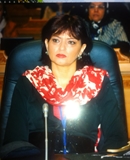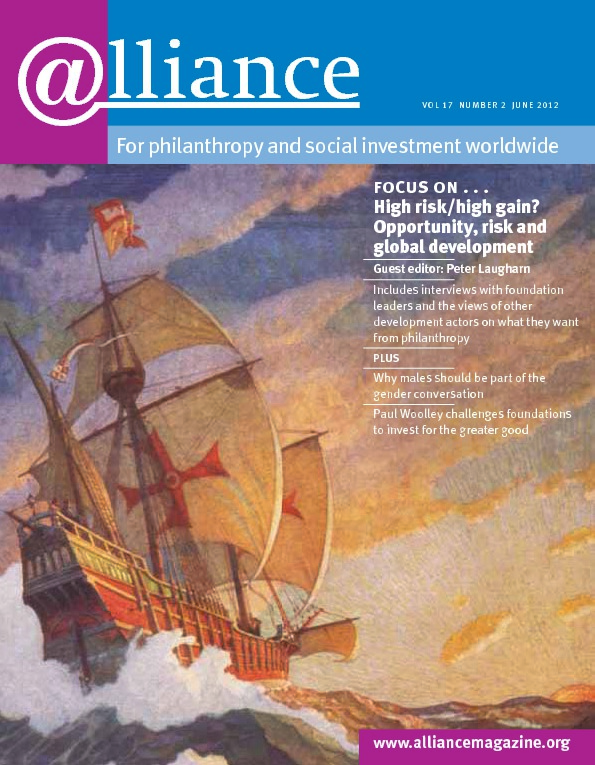Partnering with UNDP
 Najat Rochdi
Najat Rochdi
There is no development without risk-taking. If it was not risky, 60 years of working for development would have been much more successful than they have been. So what kind of risks should foundations take? I see foundations principally as sponsors of innovation, and I believe there are three kinds of role they can play in development.
One has to do with the particular foundation’s area of expertise – in livelihoods, in agriculture and so on – through which they can contribute special knowledge and insight. The second is about supporting social entrepreneurship, which is of increasing importance when it comes to local economic development and the empowerment of local communities. The third is supporting the development of the local philanthropic sector in developing countries.
When it comes to social innovation, the philanthropic sector and my own organization, the United Nations Development Programme (UNDP), have complementary roles. Foundations are more flexible – less bureaucracy, the ability to respond more quickly – so it’s easier for them to pilot innovations. The kinds of innovation I’m thinking of might be very small in terms of size or geographic scope to start with, but with scale-up potential. Foundations can provide the initial expertise or the initial push to local communities to develop the innovation until it is ready to be transformed into a business model that can be scaled up. This is where I see the philanthropic sector’s niche. Without this, we will stick to traditional and very conservative ways of addressing development because donors prefer safe programmes and issues.
It’s at the scale-up stage that partnership becomes important. Organizations such as UNDP, with its universal presence at the national and local level and its strong knowledge capital, has the framework for scaling up and assisting with the transfer of social or technological innovation and initiatives from one location to another. It’s not necessarily a matter of having the partnership in place at the outset, but of keeping in mind, in the design of the initiative itself, the need to scale up.
Coordination with the relevant local actors is crucial to the success of any development initiative. All the implementing agency’s expertise and knowledge will be useless if it’s not addressing local needs as expressed by local communities. At the scale-up stage, there needs to be coordination with the relevant authority, either local or national government; the initiative needs to fit with their development priorities and strategies. This is where a partner like UNDP comes in: it can provide the political clout and experience to negotiate with the public authority and help to bring together foundations and national and local government.
Partnership can also allow foundations to enter politically risky areas. Sometimes foundations don’t take risks because it’s impossible for them to do so. If a very sensitive issue is involved, the national government in question won’t allow them to tackle it. Because of the nature of UNDP’s mandate and DNA, and the legitimacy and neutrality it has as a result, a national government will still be open to dialogue and willing to negotiate to try to come to some sort of consensus on how to address the issue. Partnering with organizations that have the neutrality of UNDP thus makes it easier for foundations and actually offers them an avenue of access.
Another important thing that organizations like UNDP can bring to a partnership with foundations is to open up a longer time horizon. The short term is important in terms of piloting innovations, but in developing countries we need also to project ourselves in the longer term. Many foundations, acting alone, might be unwilling to do so because most operate on three- to five-year timeframes. Partnering with UNDP is a way for them to invest in the longer term; it can produce short-, medium- and long-term benefits at different stages of the life cycle of the partnership.
I’ve made the case here for foundations to collaborate with UNDP. I’ve suggested that this can allow foundations to take a greater degree of risk with a higher likelihood that it will come off. UNDP recognizes the important role foundations have to play in the development arena and the newly formulated strategy shows that things are progressing. Maybe two years ago, there was a lot of scepticism on both sides about such partnerships. There is a growing recognition now that, if development efforts are going to be successful, collaboration across sectors and between organizations will be needed.
Najat Rochdi is Deputy Director in charge of Policy, Communication and Operation at UNDP Geneva. Email najat.rochdi@undp.org
A niche for foundations
 Michael Anderson
Michael Anderson
Foundations are now recognized as an integral part of the global development community. The UK’s Department for International Development (DFID) has worked with over 20 private foundations over the last five years, and is currently co-funding programmes with six foundations. Although there is a perception that foundations have a high risk tolerance, our experience is that they often display great caution. In some cases this is understandable, but in others the drive for certainty seems to be slowing down the pace and willingness to work in areas where the metrics for success are more complex.
This drive for certainty does have a positive side. Many foundations realize the importance of focusing their efforts where they can make the biggest difference with their money, or where they have particular expertise. They are often willing to fund research to underpin their investment decisions, and will invest only when they can be sure their money will deliver results.
Supporting the systems side of service delivery
One area where we would like foundations to play a greater role is in working with developing countries on the systems side of their delivery of services. This would bring in their specific areas of expertise as well as their focus on evidence and rigour and the way they think about performance and metrics – all of which has usefully helped challenge the rest of the development community to focus more on these issues.
We are encouraged that foundations are increasingly becoming involved with education and health systems. We are currently working with the Hewlett and Aga Khan Foundations, among others, on taking the education agenda forward. There are huge gains to be made from deeper and more creative partnerships in this space, with foundations working with other players – official donors, governments, the private sector and civil society – to drive innovation and the introduction of new, evidence-based technologies and approaches, as well as new models of performance management and accountability. We want and expect foundations to continue to play this sort of role.
Engaging with less high-profile issues
There is a real opportunity for foundations to take more risk by engaging with some less high-profile, often longer-term issues. These are fundamental to international development goals, but for foundations they may seem risky because they do not promise easily demonstrable short-term results.
We are already working with foundations on some of these issues. DFID and the Gates Foundation co-fund the Technology Programme for Branchless Banking while DFID, Gates and the Hewlett Foundation co-fund the Think Tank Initiative, which aims to promote more evidence-based policy-making. We would like to see more foundations applying their skills and resources to issues like governance and transparency, education, health systems and reproductive health. Reproductive health is an area that can sometimes be politically risky for foundations. DFID is working with the Gates Foundation on a high-level family planning event this July.
Transparency and accountability is another area we would like to see foundations working on more. The Transparency and Accountability Initiative (TAI), co-chaired by George Soros’s Open Society Foundation (OSF) and DFID, aims to empower citizens to hold governing institutions to account. Other supporters include the Ford and Hewlett Foundations and the Omidyar Network. We also welcome the involvement of foundations such as Omidyar and OSF in the Open Government Partnership, a joint government/civil society initiative established by Presidents Obama and Rousseff to promote a race to the top in open government.
We would also like foundations to work towards much greater standards of reporting and transparency themselves, in particular meeting the publication standards agreed under the International Aid Transparency Initiative (IATI).
Fostering social impact funding
DFID welcomes the business skills and private sector disciplines that many foundations bring. Foundations are playing a vital role in bridging the gap between development and enterprise and challenging the wider development community to work with them in this space.
There is potentially an important role for foundations in fostering the impact investment market. If we can help existing impact investors secure demonstrable social impact with their money and encourage more people to make commitments to impact investment, this will mean more enterprises being created or strengthened. In turn, this will mean more poor people with jobs, incomes and affordable goods and services suited to their needs.
Michael Anderson joined DFID in 2001 and has been Director General for Policy and Global Issues since April 2010.
For more information
To learn more about DFID’s engagement with foundations, contact Matt Easton at M-Easton@dfid.gov.uk
A role for foundations in Rwanda
 Agnes Binagwaho
Agnes Binagwaho
There are areas of our health sector that would benefit from the support of foundations, where they can be true catalysts and where no overseas development aid is forthcoming. As with all health sector strategic planning, the areas that do need the support of foundations cannot be identified by outsiders. It is important that foundations work through us: the gaps must be identified inside the country and in a participatory manner, working with other sectors. We know where the best places are to put money to save the most lives, and have the most impact.
This does not mean that the government wants to dictate the terms of any intervention or even to be the implementing agency in every case. We see our role as being there to offer guidance and to help coordinate. We would introduce a foundation to all partners in particular areas, ourselves included. We would advise on a place where their investment could have a real, long-term impact.
For example, we might have a shortage of midwives and decide that we would like a foundation to help us set up a system to train more midwives. We lack knowledge in many areas today, but the lack in health is particularly urgent because it kills people. Another area where foundations might play a role is in addressing the high rates of depression in children with HIV. Given that it is not always appropriate to treat clinically depressed children with drugs, the solution is often counselling. However, there needs to be a more proactive approach to developing the skills that will allow professionals to quickly diagnose the depression and respond to it. This is another area where foundations could be highly influential.
Are there risks involved for the foundations? Of course. Take the search for a vaccine to counter a killer like malaria or HIV, for example. This carries both the great risk of possibly not discovering a vaccine and a potentially tremendous benefit if you are successful. And yet the real failure is doing nothing at all when there is a possible solution. In global health, the cost of inaction is monumental. The health sector in Rwanda understands health to be a basic human right; and we welcome foundations that wish to join on our journey to ensure that we are always able to act on health risks and inequities, and that the social outputs of our collective investments affect the lives of all Rwandans.
Agnes Binagwaho is minister of health for Rwanda. Twitter: @agnesbinagwaho
Foundations and the World Bank
 Penelope Lewis
Penelope Lewis
Foundations and the World Bank Group have a long history of working together. Today there are over 40 foundations working in partnership with the World Bank in areas as diverse as health, education, fragile states, good governance, gender, agriculture, the environment, and water and sanitation. Partnership makes sense because it builds on our very different strengths. When we work together, using our comparative advantages, we can shift thinking and deliver ground-breaking results.
From the World Bank’s vantage point, foundations are risk takers, nimble and inventive. They can move quickly and adapt to changing circumstances. They can pilot new and exciting ideas. At their best, they are pioneers in the world of development. Some philanthropy insiders challenge the idea that foundations take risks or that they invite failure as a way to learn how to do things better, but their freedom and agility does give them the predisposition to do so. And in many cases they fulfil this potential.
The World Bank is fundamentally different in character, with a different set of strengths. We have 188 shareholders. We are a large and decentralized body of more than 10,000 staff, a third of whom are based across the developing world in 124 country offices. We have an annual commitment of more than $57 billion (FY 2011) and a treasure trove of development knowledge and expertise.
By partnering with the World Bank, foundations plug into our global reach, our capacity to deliver projects at scale, and our leverage with governments to influence change at the policy level. For the World Bank, foundations play a crucial role in keeping us connected to innovation and close to community-based solutions. We see foundations as the risk capital for development, change agents pushing alternatives that need to be tested, analysed, evaluated and re-tested before they can become mainstream.
The best examples of partnership, whether around tertiary education in Africa or microfinance in Syria, are those that most successfully marry our comparative strengths, producing creative strategies for solving some of the thorniest challenges in development.
Penelope Lewis is head of the Global Foundations Program at the World Bank. Email plewis@worldbank.org
Where are development’s venture capitalists?
 Duncan Green
Duncan Green
Research increasingly shows that on everything from how to stimulate economic growth to how to improve the quality of public services, there are multiple pathways to success. What’s more, what works in one place and time may fail in another. Rather than searching for a non-existent universal ‘best practice’, we need new ways of understanding how change happens that describe this complex, pluralist world. The best model I have seen is evolutionary theory, memorably described in Eric Beinhocker’s important book The Origin of Wealth.
Beinhocker shows that the evolutionary process of random variation, followed by selection of ‘fit’ variants (and the extinction of non-fit ones) and their rapid amplification, is a much better description of the economy than economics’ preferred paradigm, drawn from 19th-century physics, of systems that always seek to return to a stable equilibrium.
What has such abstract thinking got to do with aid? Aid agencies tend to be risk-averse – no politician wants to see newspaper headlines about taxpayers’ money lost or ‘wasted’ on failed projects; NGOs like Oxfam are determined to make every hard-won penny count (and worried about what our supporters will say if it doesn’t). But there is increasing recognition that such caution comes at a cost: all too often, low risk is accompanied by a low return on investment. Compare this approach to a venture capitalist who, perhaps unwittingly, imitates the evolutionary process by backing ten projects knowing that nine will fail (and on the tenth ‘fit’ one, he/she will make enough money to more than compensate for the other failures).
 Could such a high risk/high return approach work in development? I think the answer is an emphatic yes, not least because I’ve seen it in action on the ground in Tanzania. With backing from the UK’s Department for International Development (DFID), Oxfam is running a programme[1] explicitly modelled on evolutionary theory to improve the accountability of local authorities to their citizens. In the first phase, the programme sets lots of different hares running, from ‘farm animators’ to ‘active musicians’ (pictured) to primary school student councils. It then selects the fittest variants (or allows natural selection, as projects multiply or die of their own accord). The final phase will be amplification: creating an enabling environment and promoting synergies between different initiatives, but otherwise staying out of the way so that new ideas bubble up from the grassroots.
Could such a high risk/high return approach work in development? I think the answer is an emphatic yes, not least because I’ve seen it in action on the ground in Tanzania. With backing from the UK’s Department for International Development (DFID), Oxfam is running a programme[1] explicitly modelled on evolutionary theory to improve the accountability of local authorities to their citizens. In the first phase, the programme sets lots of different hares running, from ‘farm animators’ to ‘active musicians’ (pictured) to primary school student councils. It then selects the fittest variants (or allows natural selection, as projects multiply or die of their own accord). The final phase will be amplification: creating an enabling environment and promoting synergies between different initiatives, but otherwise staying out of the way so that new ideas bubble up from the grassroots.
Last September came the difficult bit – killing off the less successful experiments. In consultation with the partners, we devised four criteria on which to judge the pilots: how much were they spreading awareness? How successful were they in mobilizing people to take action? How effective were they at expanding ‘spaces’ in which people can claim their rights? And how responsive was the government (either local or national)? As a result, we dropped some pilots and merged others. Overall, the farm animators came out best. The musicians were better at awareness raising and mobilization, but failed to get a good government response. The student council approach was dropped and spun off to another funder (one unintended consequence of the venture capital approach: generating other fundable spin-offs).
So far, the results are extremely encouraging and are having a profound impact on the way Oxfam works in Tanzania. ‘We’re doing something different now,’ says programme coordinator Jane Lonsdale, ‘not just rolling out a load of community scorecards, or public expenditure tracking – the usual kind of governance work. … Everyone is picking up trends and patterns – it’s a lot better than using conventional [impact] indicators.’
We would love to do more of this, but sadly DFID’s willingness to fund an experimental programme of this kind, with lots of (relative) failures expected, is exceptional. Most funders want to see, in advance, a plan with a set of activities and intended results, against which the recipient’s performance can be evaluated (and the donor’s cash justified). ‘We’ll try loads of stuff, ditch the less successful ones, and see where we end up’ is not usually a compelling funding pitch, even if it is a much more sensible (and accurate) approach to development work.
Foundations ought to have some cultural affinity with venture capitalist approaches, given that most of their founders were VCs or at least entrepreneurs back in the day. So if any of them want to discuss setting up a ‘social VC’ facility, feel free to get in touch!
1 http://www.accountability.or.tz
Duncan Green is senior strategic adviser at Oxfam GB. He writes a daily development blog, From Poverty to Power. Email DGreen@oxfam.org.uk
Sharing the risk with communities
 Sheela Patel
Sheela Patel
Poor, marginal and vulnerable individuals, communities and households living in survival mode are often denied the mantle of good governance by the state, which may ignore them or deny their very existence, and this vacuum is often filled by other exploitative actors.
Foundations and grantmakers are often invited to assist and finance the formulation of associations or organizations of these groups so they can seek accountability from their nation state, or whatever face of the state they interact with. These communities take a huge risk to explore this alternative. Sharing such a risk is a risk increasingly foundations don’t want to take – especially since it never fits the timeframes of projects and rarely gives clean outputs and outcomes initially. Yet of all investments this is the most critical and sustainable.
 Supporting such endeavours and those that facilitate them in local and national contexts means sharing the risks with these communities. As someone associated with a movement of squatters in cities in Slum/Shack Dwellers International (SDI), I find foundations embrace the risks of project-based and market-linked strategies more easily but shy away from the real fundamental challenges of exclusion, which take time.
Supporting such endeavours and those that facilitate them in local and national contexts means sharing the risks with these communities. As someone associated with a movement of squatters in cities in Slum/Shack Dwellers International (SDI), I find foundations embrace the risks of project-based and market-linked strategies more easily but shy away from the real fundamental challenges of exclusion, which take time.
Sheela Patel is director of Society for the Protection of Area Resource Centres (SPARC), and chair of SDI. Email sparcssns@gmail.com
Foundations as altruistic investors
 James Mwangi
James Mwangi
Foundations must start viewing themselves as altruistic investors who pursue high rates of social return on their capital. Rather than looking at how much they give, they need to focus single-mindedly on how effectively they invest alongside others to achieve sustainable social change. I would offer four general suggestions.
Ensure that all investments recognize the capabilities and assets of communities and not just their needs. Narrowly targeted interventions that ignore local insight and capacity can do lasting damage to the ability of communities to develop their own sustainable solutions. A good example is the many instances of market spoilage where generous gifts destroy the livelihoods of local providers (eg cheap or free commodities that kill emerging local enterprise instead of fostering it). To avoid creating self-perpetuating cycles of dependency, foundations must understand the role of indigenous innovators and entrepreneurs and find ways to support them.
Pursue large-scale impact but be honest about where in the value chain foundations can actually play. While private philanthropy represents a significant pool of resources, it is generally dwarfed by the scale of development challenges. Many foundations work either in ignorance of or in direct competition with each other’s activities; they fail to understand their ecosystem and define complementary roles alongside other development actors. Roles could range from small local foundations providing small but flexible early-stage grants to larger international players picking up proven concepts and giving them the funding they need in order to scale up. Finding like-minded and complementary funders, and understanding their respective capabilities and roles across the lifecycle of initiatives, is an underutilized key to meaningful long-term impact.
Think systemically and do not operate in a vacuum. Foundations often suffer from a general tendency to keep government and business at arm’s length. Actively building broad networks and relationships with these actors can enable foundations to consider how they can catalyse, complement or supplement private and public investments that often have impact at a much bigger scale.
Demand results while accepting risk and embracing the lessons of failure. The broader development sector today is hampered by the inability to frankly recognize and learn from failed efforts, due to a justified fear that such failure can lead to loss of critical funding. One of the key roles foundations can play is driving experimentation and innovation through their comfort with taking on risk. They should therefore be in a unique position to embrace rigour in tracking their results while resisting the impulse to stigmatize failures.
James Mwangi is Global Managing Partner of Dalberg – Global Development Advisors. Email james.mwangi@dalberg.com
Developing the capacity to aspire
 David Harrison
David Harrison
Foundations can work where governments and bilateral funders don’t want to, or can’t. Here, I’m not only talking about geographical areas or working with stigmatized people, but about the intangible spaces between institutions and programmes. They can work with the fabric of society, with the culture that shapes the way people think and act.
Often, funders shy away from culture because they view it as an inviolate set of rules that must be respected by outsiders. But, as the anthropologist Mary Douglas said, culture is a ‘dynamically interactive and developing socio-psychic system’ – interacting not least with the socioeconomic circumstances in which people find themselves. Where communities feel excluded and stifled, they tend to be fatalistic and tolerate destructive risks such as HIV and corruption. Where communities feel included and perceive choices for themselves, they tend to take risks that lead to innovation. Another anthropologist, Arvin Appadurai, refers to this as the ‘capacity to aspire’. Ultimately, the success of investments in programmes in these communities depends on the degree to which this capacity can be developed.
What does this mean for foundations? They should be willing to invest in community organizations that build social solidarity – even if, or precisely because, such organizations will change power differentials. They should invest in creating new connections, both social and economic, that bridge the poles of highly polarized societies. And they should invest in building a new identity for people who are typically defined by deficit.
In this regard, there is no more important group than young people, who tend to be characterized as unemployed, undereducated, a ‘ticking time bomb’. Foundations need to find young people who have begun to emerge as leaders in their own communities, but whose social and economic distance from the mainstream means they cannot participate fully as citizens of their countries and the world. By connecting them and developing their ability as public innovators, we can build a strong national and transnational identity of leaders grounded in local realities and committed to public innovation and social justice.
David Harrison is CEO of the South Africa-based D G Murray Trust. Email david@dgmt.co.za





Comments (0)